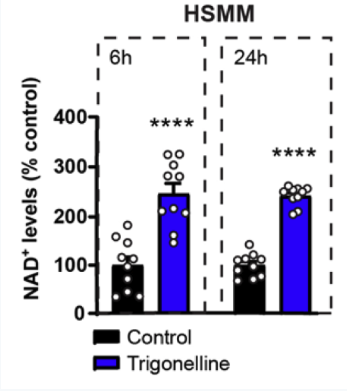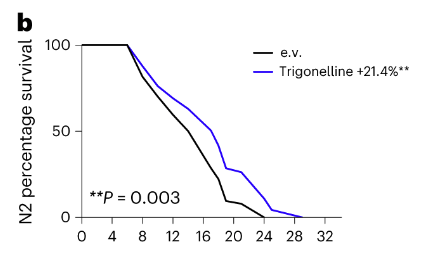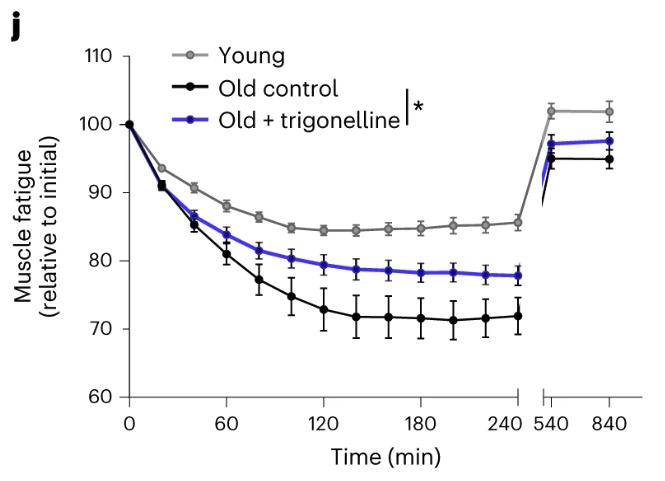This study investigates the role of trigonelline (TRG) as a potential NAD+ precursor and its effects on muscle function in aging in cells, worms, mice, and humans.
“Our results add trigonelline to the list of established dietary NAD+ boosters.”
Key Points:
TRG has potential therapeutic benefits for managing sarcopenia, an aging disease hallmarked by reduced muscle strength and walking speed:
- Extended lifespan in worms.
- Improved muscle function.
- Improved mitochondrial function and biogenesis.
- Offers advantages over other NAD+ precursors, like NA.
- May treat decreased strength and muscle loss.
“Patients with sarcopenia had lower circulating concentrations of trigonelline, a natural alkaloid found in plants and animals, including in humans.”
Trigonelline: A New NAD+ Precursor
Chronic dosing of TRG led to a marked increase in NAD+ levels across models.
Notably, TRG boosts NAD+ through different pathways than NA, NR and NMN reaching different tissues, with indications it is more effective at increasing NAD in muscle and brain.
- In human muscle cells treated with TRG, researchers found a 50% increase in NAD+ levels.
- In mice, this increase was also noted in whole blood, liver, muscle, and kidney samples.
- This study also observed increased NAD+ levels in the skeletal muscle of older adults.
“Altogether, these results demonstrate that trigonelline is a bona fide NAD+ precursor that is directly incorporated in NAD+ in cells and multiple tissues.”

This figure depicts the increased NAD+ levels in human muscle cells 6 or 24 hours after TRG administration.
“Trigonelline increased NAD+ in control cells, fully rescued NAD+ deficiency, and also increased NAD+ levels after prolonged treatment.”
Advantages Over Other NAD+ Boosters
TRG converts to NA for NAD synthesis, but avoids NA’s flushing side effect by not activating the responsible receptor, making it better tolerated at high doses.
It is also more stable in serum than NR and NMN meaning it survives longer in the blood stream before being converted to NAD, potentially allowing for sustained long term delivery.
TRG is highly bioavailable and does not appear to alter levels of other precursors.
The number of available NAD precursors suggests that there may be some physiological specificity in different organs and tissues.
“Trigonelline was remarkably stable in serum over 72 h, whereas NR and NMN rapidly disappeared within hours after conversion to NAM.”
TRG Extended Lifespan in Worms
TRG supplementation improved muscle fiber integrity during aging in C. elegans worm models.

This figure shows the increased survival of chronically dosed worms (blue) compared to the control (black).
“Trigonelline significantly extended the lifespan, with comparable effects to equimolar levels of NR.”
Improved Muscle Strength and Decreased Fatigue
Researchers measured the grip strength and muscle fatigability in young untreated mice compared to aged mice treated with TRG for 12 weeks.
- Young mice (n = 15): Normal diet
- Aged Mice (n = 13): Normal diet
- Aged Mice + TRG (n = 15): 300 mg/kg body weight orally per day

This figure depicts reduced muscle fatigue associated with chronic TRG dosing in aging mice. The treated mice (blue) scored higher than the untreated aged mice (black), with results closer to young mice (grey).
“In this setting, which mimics a physiological situation where the performance of healthy young mice decreases by 10% during the fatigue protocol, muscle fatiguability was tripled in aged mice but trigonelline prevented approximately 50% of this age-related decline.”
Restored Mitochondrial Function
Low NAD+ levels contribute to diminished mitochondrial function.
- In NAD-deficient cells, TRG fully restored the functionality of the mitochondria.
- Cells showed an increase in gene expression related to mitochondrial remediation.
“Our preclinical experiments demonstrated that trigonelline is an NAD+ precursor that optimizes mitochondrial function to improve muscle strength and prevent fatigue during ageing.”
Conclusion
The research presents a clear association between trigonelline and muscle health in humans and several animal models.
“Because of its high bioavailability and serum stability, trigonelline can reach the brain and impact cognitive performance in mice with Alzheimer’s disease, therefore holding potential for neurocognitive benefits in addition to muscle health.”
“In addition, trigonelline can protect from metabolic dysfunction and improve glucose tolerance both in mice and humans”
“Therefore, trigonelline is a nutritional geroprotector with therapeutic potential to manage sarcopenia and other age-related pathologies.”
